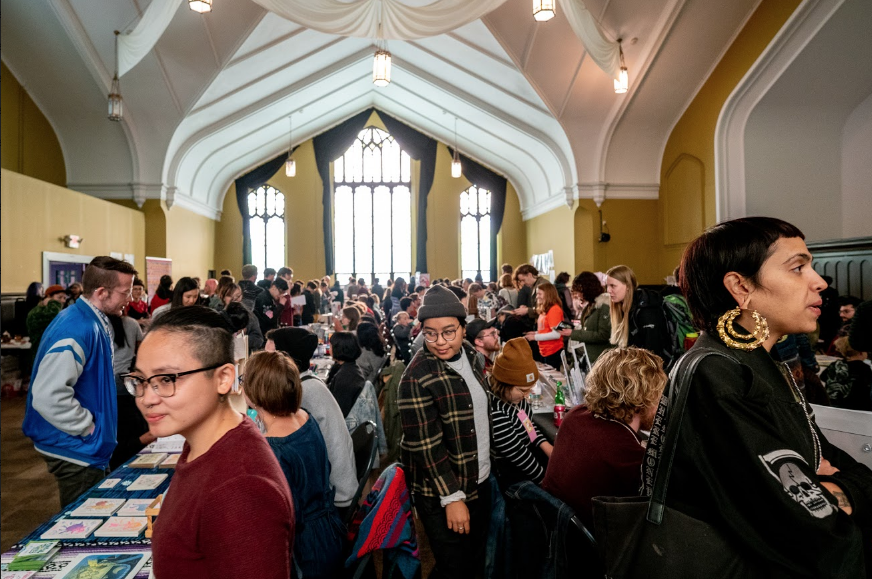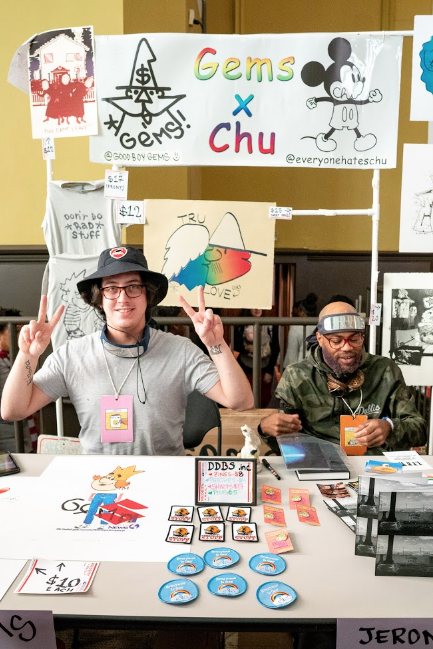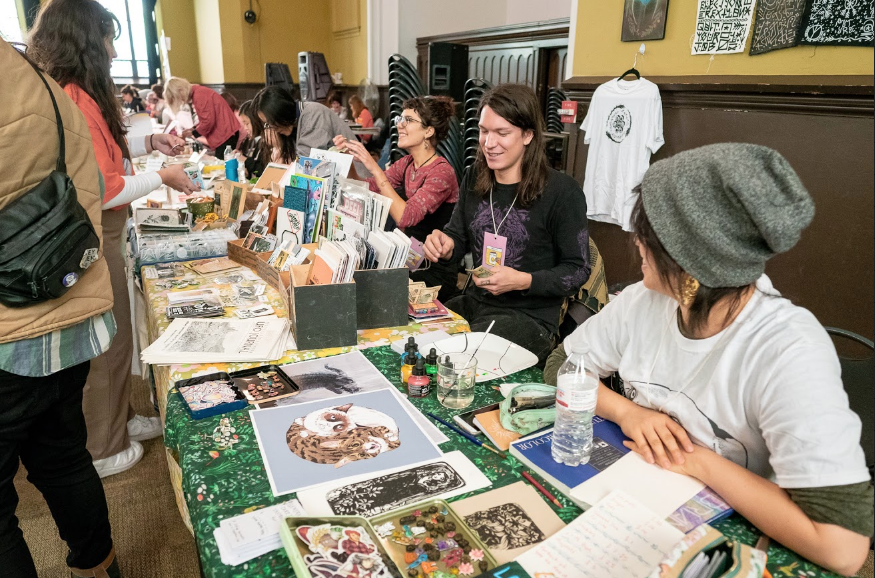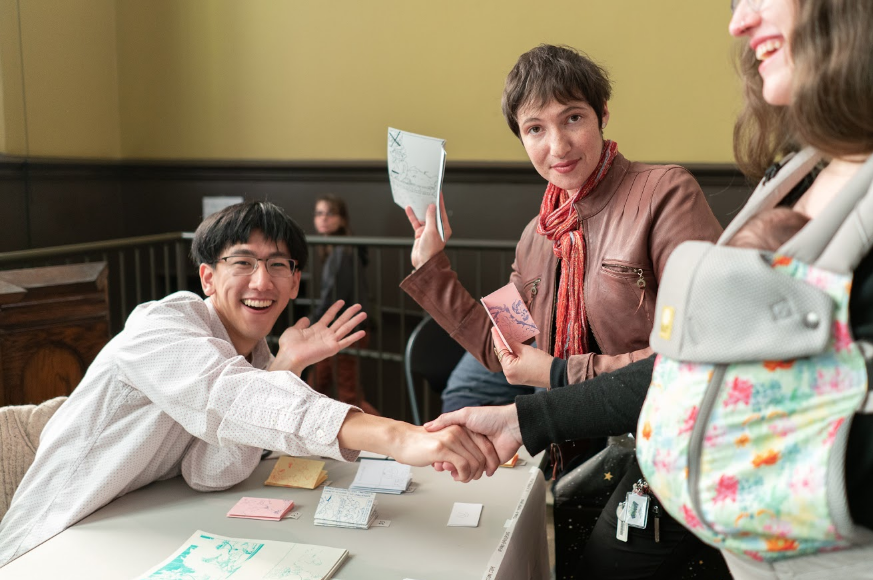The Idea Factory + PZF 2018
📝This archived post is originally from my old comics focused Wordpress blog from 2011-2019. That site was a space to publicly commit to learning the art and craft of cartooning and self-publishing.
These posts are full of a naive enthusiasm that though at times embarrassing, I'm proud of. I hope you find them useful in some way.❤️
Last weekend was a brilliant doozy here in Pittsburgh. I mentioned that it was a busy one, so you knew something was coming!
I was programmatically double booked, with a cartooning program, the Idea Factory, from 10am-4pm at the Children’s Museum on Saturday and Sunday, and then as one of the head organizers of the Pittsburgh Zine Fair the zine fair’s annual mixer and reading from 4pm-7pm and the main zine fair event from 2-8pm. Combining the setting up, the striking, the picking up of a U-haul and tables Sunday morning at 6am… It was a lot. Thankfully, I wasn’t afraid to ask for help and got the much-needed assistance from the cartooning team that I scheduled at the museum, and my fellow zine fair organizers. Thank you so much.
I was anxiously going over all possible scenarios, load-ins, transitions, shifts at the museum, and above all the zine fair set up. This anxiety filled all last week, so I’m happy to say that it all went swimmingly. I hate that feeling of anxiety trying to get all of your ducks in a row while an event looms ahead, especially when certain things can only come together last minute, but it’s that feeling that drives me to be careful and make sure that everything goes without a hitch. Especially when you’re in a sequence of weekend that all follow each other, in this case, SPX and CXC happening every other preceding weekend… We made it through folks!

The Idea Factory was a concept that I came up with Zena Ruiz, the Children’s Museum of Pittsburgh’s Program Manager. The idea was to create a playful space for an imaginary patent office for contraptions. The goal was to come with ideas for Rube Goldberg style contraptions and draw out blueprints for these contraptions, live, and for kids to take them home to decorate their homes. This process was to be a collaborative one between children visiting the museum and local cartoonists. I was the ringleader of this drawing circus. On hand I had a great crew that comprised of Jennifer Lisa, Audra Stang, Asia Bey, Caleb Orecchio and Camden Yandel. They were my brilliant inventors.
When visiting the Idea Factory, the kids found prompts on colored paper all around the room. These prompts invited them to make a contraption that did a certain thing, buttered toast, brushed a horse’s hair, fed a goldfish, etc. They did this on letter size sheets of white paper. When they were done, they brought their finished draft to the inventor/cartoonists. Children were visiting the museum with their parents so my team had plenty of parental assistance when kids were confused, stuck or needed a snack.

 For my crew of cartoonists, their primary role was to work with kids to take their ideas to JUMBO size with writing and clear drawing. Using a big black marker, the cartoonists reviewed over the drawings with the kids asking them about what they drew. How one part connected to the next part and the next part. This was done by having the child work witht the constraints in the prompts and arrive at a workable silly or serious, though usually silly, drawing. Then they went up to the cartoonists and described their machine. The cartoonist the wrote down the play by play in the tradition of Rube Goldberg’s cartoons. Then they worked together to draw, color and label the jumbo blueprint version of their machine. It was REAL.
For my crew of cartoonists, their primary role was to work with kids to take their ideas to JUMBO size with writing and clear drawing. Using a big black marker, the cartoonists reviewed over the drawings with the kids asking them about what they drew. How one part connected to the next part and the next part. This was done by having the child work witht the constraints in the prompts and arrive at a workable silly or serious, though usually silly, drawing. Then they went up to the cartoonists and described their machine. The cartoonist the wrote down the play by play in the tradition of Rube Goldberg’s cartoons. Then they worked together to draw, color and label the jumbo blueprint version of their machine. It was REAL.
This was essentially a writing and editing exercise that allowed children to see how their ideas translated across forms. Of course, that was all going on under the hood. On the surface, the kids were drawing their inventions with inventors! It was such a blast.
Besides having fun, the underlying goal was to create a collaborative moment between adult and child of communication and collaborative work - where the child could see their idea fleshed out by someone else. In this sense, it would allow them to be listened to. That their ideas are worthy of attention. This sense of validation is very important to me in the workshops that I lead, with both adults and children. All of this in the tradition of Fred Rogers.
A huge thank you to Zena for inviting us to spend these two amazing days at the museum during Rube Fest. Another huge thank you to museum staff who were always on hand to solve any problems that came up!


What else? Well, the Pittsburgh Zine Fair returned to its home base, the Union Project on Sunday!
Naturally, by this point of the weekend I was beat. All of the previous week, I was on the verge of tears balancing all of this stuff all of last week on top of my day job and getting some sleep. I can’t tell you what a relief it was at 4pm when my old radio pal, dj extraordinaire Allison Cosby stepped up to the plate play a set of reggae and dub on WRCT Pittsburgh’s mobile rig. It was bliss. The sun was beaming in through the stained glass windows, the dub warmed my body with its groove, the wall of noise of chatter fluttered around me. People were smiling, trading, spending money, eating tacos, catching up, meeting for the first time. In all the wretched isolation that comics creates as a commodity form, these moments are what I live for. People really sweetly asked if I had some new comics and zines and I smiled that I’d been busy with other work. Thankfully, they got it.
 Pittsburgh Zine Fair 2018 - photo by Di-ay Battad
Pittsburgh Zine Fair 2018 - photo by Di-ay Battad
In it’s eight iteration, the zine fair is a real community production. For example we don’t get access to the space until 1pm, so the first 15 minutes is us all collectively working together to get all 38 tables set up and to get all exhibitors in their spots! It’s a zine fair so we fly low to the ground and are super agile/flexible. Despite that, it was still a super stressful 15 minutes this year. Thankfully, exhibitors Max Gonzalez and Jerome Charles stepped up and helped me direct folks to where tables needed to go. And, as per usual everyone was game to lend a hand and make it happen. And, make it happen we did.
Thom Delair, Raiona Gaydos, Jennifer Lisa and Kate Harmon all pitched in and helped things flow during the fair where we received 790+ attendees from 2-8pm. Wild. We were all wearing many hats that day, organizer Christina Lee was hustling her wares and repping her new print studio, Pullproof Studio, and organizer-on-hiatus/ new-momma Maggie Negrete was there showering her yet-to-be-month-old Mora in the glow of zines. It was a family affair.
We were lucky to have Di-ay Battad snapped some photos right as we opened our doors:
We’re proud of how affordable we can keep table fees. We charge $10 for a 1/2 table and $20 for a full, this is thanks to our low overhead and the great relationship we have with our host site, the Union Project. This important to me personally. This cost allows people to experiment with publishing techniques, commit to publishing things and ideas that are hard to sell, while ensuring that they won’t have to dig themselves out of a financial hole because of their self-publishing.
This year we received 143 applicants but could only offer spots to 64 exhibitors -ACK - this put us in a pickle as to our curatorial process. Above all we wanted, as we always do, to uplift the work and voices of marginalized makers while creating a fertile and ecologically diverse intellectual and artistic landscape in Pittsburgh. The head organizers got together + 6 volunteers and we evaluate our applicants along several axes to arrive at our 64. It went smoother than any prior year, but it was a whirlwind of a process. Though it wasn’t easy, but it seems to have been successful as multiple people came to me explicitly to tell me how much they enjoyed the variety of zinesters on hand.
It’s important to take note, this is a zine fair, not comics show, not an art book fair. There’s nothing inherently wrong about those things, but there are some things that inevitably get lost in those spaces. Aesthetics and popularity before community and empowerment, more often than not.
At the Pittsburgh Zine Fair, we hold in highest regard the idea of democratic multiple and the self-authorization that zines give our community of makers. A high school poet who has been exhibiting at the fair for 3 years now mentioned that she wants to work with the zine fair to organize a high school zine fair in the coming year. What could be more exciting than that? That’s what I’m here for.
-juan







